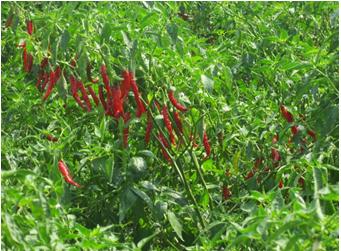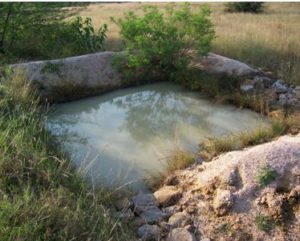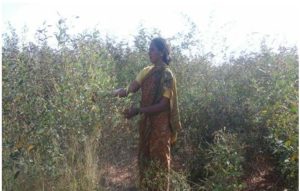Climate change and Challenges
Increased uncertainties in climatic variability have become a major challenge for sustaining agriculture as well as its allied sectors in the face of already declining natural resource base. Agriculture is the main livelihood system of most of the people and particularly for women in terms of employment, wage and assuring food security of the family and particularly the children. India’s food production is likely to be affected by the climate sensitivity of its agriculture and this in turn will impact on poverty and livelihoods. Agricultural productivity is sensitive to two broad classes of climate induced effects – direct effects from changes in temperature, precipitation, and carbon dioxide concentrations and indirect effects through changes in soil moisture and the distribution and frequency of infestation by pests and diseases. The recent calamities of floods, cyclones and droughts effected several states particularly Uttarakhand, Bihar and Southern region of Andhra, parts of Karnataka and Telangana and particularly the vulnerable population of women and children.
YFA’s experience:
YFA has promoted mitigation and adaptation activities to prevent and reduce health and livelihood shocks contributed by Climate Induced Disasters. Promoted and harnessedtraditional and modern science to predict weather and data analysis to reduce livelihood risks including planning of agriculture. Educated farmer groups to reduce the use of chemical fertilizers, pesticides and water intensive crops to arrest exploitation of fossil fuels and reduce methane gas in the atmosphere.
Erratic rainfall and fluctuating temperatures have been creating havoc in Mahabubnagar district in Telangana. People particularly women could identify the changes in weather patterns relating to the resources availability. For example, the women and women farmers have been responsible for collecting water, brining fodder, sometimes collective fuel wood, sowing of various crops and cooking of food. YFA staff had detailed discussions that how these changes bring impacts on their lives and particularly the food security situation of the family. The women revealed that over a period of time access to natural resources of fodder, green manure, water and quality of food has been decreasing as the resources and rainfall is shrinking. They further recalled the major change they have started experiencing from the year 2008-09 when their villages faced drought and followed by huge floods during the year 2010-11. Since then, their life found to be difficult and then the strikes and social unrest for demanding separate state compounded the problem of food security. Earlier we could not manage the natural calamities as we could not enjoy get access to information particularly on weather and agriculture crop management – said Annapurna of Erladinne village. Today, forecasting and making predictions have been little easy as the data has been properly collected and average reliability of rainfall and other aspects have been analyzed and discussed. We women and men of sangha always share the reports and initiate proper action to mitigate the impact of manage drought. For example, during the last year majority of the farmers could not sow the crops and some farmers planted paddy or groundnut under irrigate conditions could face the risk of uncertainty and had to loose large 60% of the crops. Whereas, the targeted group members have planted dryer crops which require less moisture, less inputs and experience less pest attack and could harvest 60-75% of the crop produce and have become models for both mitigation and adaptation activities. What the women and men farmers needed here is the information about the local conditions and advice that can help them make strategic and tactical decisions for their livelihoods and agriculture operations. The weather centres reduced the risks of the targeted group members and managed to record marginal harvest despite local climatic variations. YFA is positive that the implementation of the measures would be replicated by other agencies in the coming years.
Use of Panchakavya:
 Panchakavya, an organic product has the potential to promote growth and providing immunity in plant system. It is made of 5 cow products (cow urine, cow dung, cow ghee, cow milk and cow curd) and kept for formation and the same stock is used for controlling pests and plant growth in agriculture. The trails on use of panchakavya was laid in 10 acres with 10 no of farmers in castor, redgram, sorghum, vegetables (chilli) and paddy crop and sprayed during crop growth stages (vegetative, flowering and fruiting stages) noticed good plant growth, increased spike length castor, panicles in paddy and no of pods in redgram. Good plant growth and flowering and fruiting (300 gms of green chilli per plant) was recorded in chilli crop. Increased yields of 9 to 14% is noticed in all the trial crops. Farmers of the trail were impressed about the effect of panchakavya and noticed that it possess almost all the major nutrients, micro nutrients and growth hormones (IAA & GA) required for the crop growth. But unfortunately the expected yields could not be achieved due to heavy rains occurred just before the harvest. The solution also contains predominance of fermentative micro-organism like yeast and lactobacillus, which produce organic acids, hydrogen peroxide, antibiotics. These trial has helped the farmers and reduced 2-3 chemical sprayings, thus fetched Rs.800-1200/acre savings.
Panchakavya, an organic product has the potential to promote growth and providing immunity in plant system. It is made of 5 cow products (cow urine, cow dung, cow ghee, cow milk and cow curd) and kept for formation and the same stock is used for controlling pests and plant growth in agriculture. The trails on use of panchakavya was laid in 10 acres with 10 no of farmers in castor, redgram, sorghum, vegetables (chilli) and paddy crop and sprayed during crop growth stages (vegetative, flowering and fruiting stages) noticed good plant growth, increased spike length castor, panicles in paddy and no of pods in redgram. Good plant growth and flowering and fruiting (300 gms of green chilli per plant) was recorded in chilli crop. Increased yields of 9 to 14% is noticed in all the trial crops. Farmers of the trail were impressed about the effect of panchakavya and noticed that it possess almost all the major nutrients, micro nutrients and growth hormones (IAA & GA) required for the crop growth. But unfortunately the expected yields could not be achieved due to heavy rains occurred just before the harvest. The solution also contains predominance of fermentative micro-organism like yeast and lactobacillus, which produce organic acids, hydrogen peroxide, antibiotics. These trial has helped the farmers and reduced 2-3 chemical sprayings, thus fetched Rs.800-1200/acre savings.
A Case Study on Farm Pond Technology
Mahesh is a dynamic marginal farmer of Mamdapur village, Pangal Mandal owns about 4.0 acres of dryland and mostly cultivated castor, jowar, redgram. He is very interested to cultivate horticultural crops as well as irrigated dry crops like groundnut, sunflower etc, but the water table in the well did not encourage him. Mahesh tried 2 times to drill bore in his dryland but the water level does not satisfy him to go for ID crops. So he always felt unhappy and was abusing his fate.
 During one of the field visit programmes, he interacted with YFA team. After discussing his problem, YFA team has visited that land and noticed that the bore which he has drilled located near a narrow stream. After this field inspection, YFA team suggested to construct a 0.01% farm pond beside the his dried up existing bore. YFA team assisted him financially for digging farm pond and by employing sangham women as a labour to work. Mahesh and his family (his wife & brother) were also involved in work. He has constructed farm pond (size in 6 feet length, 6 feet width and 8 feet depth*) using local labour and stones for pitching the source water channel so that the soil and silt can be deposited and pure water can trickle down to farm pond. The silt so deposited can be spread on his land to improve the top soil and carbon content. After construction of structure, the summer season followed with monsoon and a recorded rainfall of 460.81 mm received in the area. Earlier the rain water used to get run-off but with construction of farm ponds the run-off water accumulated in the farm pond which increased the availability of surface water and recharged the groundwater potential. It was recorded that there were 6 spells of rainfall and the first four rainfall spells were useful in groundwater recharge and the remaining two spells were visible above the ground level. Such process has controlled the water run-off and resulted in enhanced water level in the borewell and it was found that the borewell was discharging about 1.5 inch of water, sufficient for growing 2 acres of groundnut or pulse crops. This borewell was totally dried up and I left farming and used to search for labour work. But now, I am totally engaged in farming and also providing labour for 6 families of my sangha – says Mahesh and his wife.
During one of the field visit programmes, he interacted with YFA team. After discussing his problem, YFA team has visited that land and noticed that the bore which he has drilled located near a narrow stream. After this field inspection, YFA team suggested to construct a 0.01% farm pond beside the his dried up existing bore. YFA team assisted him financially for digging farm pond and by employing sangham women as a labour to work. Mahesh and his family (his wife & brother) were also involved in work. He has constructed farm pond (size in 6 feet length, 6 feet width and 8 feet depth*) using local labour and stones for pitching the source water channel so that the soil and silt can be deposited and pure water can trickle down to farm pond. The silt so deposited can be spread on his land to improve the top soil and carbon content. After construction of structure, the summer season followed with monsoon and a recorded rainfall of 460.81 mm received in the area. Earlier the rain water used to get run-off but with construction of farm ponds the run-off water accumulated in the farm pond which increased the availability of surface water and recharged the groundwater potential. It was recorded that there were 6 spells of rainfall and the first four rainfall spells were useful in groundwater recharge and the remaining two spells were visible above the ground level. Such process has controlled the water run-off and resulted in enhanced water level in the borewell and it was found that the borewell was discharging about 1.5 inch of water, sufficient for growing 2 acres of groundnut or pulse crops. This borewell was totally dried up and I left farming and used to search for labour work. But now, I am totally engaged in farming and also providing labour for 6 families of my sangha – says Mahesh and his wife.
* Calculations:
Size : 6’ x 6’ x 8’
Depth of water : 3.5’
Quantity of water : 6’ x 6’ x 8’ = 288 cubic fts i.e. 2154.39 gallons
No.of fillings : 6
Low cost organic farming found to be good strategy for mitigation and adaptation – an example of Rainpally village:
 Rainpally is a sleepy village in Pangal Mandal used to be one of the resource rich area about two decades ago. But now, it reflects as one of the vulnerable village frequently experiencing natural calamities of erratic rainfall and sometimes heavy rainfall and hailstorms. During the winter months of 2013-14 the village lost large amount of standing crop due to untimely winter rains and winds and thereafter, during the year 2014-15 the village is experiencing severe drought putting people into hardship. In these circumstances, the village sangha and its committee had several discussions with YFA team to counter and manage the natural calamities and at the same time managing their food security needs. The discussions in several meetings concluded that the risks of the people can be reduced provided the group agrees to collectively change their cropping pattern; change their input use; optimize the use of water and work towards building the top soil fertility. This strategy required the group to undergo a detailed training and YFA agreed to organize such trainings and also assist in organizing demonstrations for alternative low cost crop production strategies. Accordingly, a group of farmers were prepared and the farmers like Laxmi have been chosen as one of the change agents. She efficiently implemented an organic farming model and today found to be one of the best farmers in the village. She said that earlier I never used to think about alternative farming and particularly the changing weather patterns and its impact on agriculture and so is the high utilization of water and chemical inputs. She further said that she has changed her cropping pattern from Paddy to Pulse crop of Redgram which would require lessor water. She adopted the alternative inputs of farm yard manure (FYM) when enquired about her experience it was revealed by her that the seeds given by YFA was treated the Trichedermavirdi by her and before sowing the seed she put about 1 tractor load of FYM and after that ploughing undertaken. After 30 days of the crop weeding was done by me and then I have spread neem powder. After 35 days of the crop I have used Neem oil with Garlic extract and undertaken spraying on the crop. After 50 days of the crop I have prepared Panchakavya and once again spraying done by me. After words during the fruiting stage I prepared Tulasi extract with neem oil and sprayed around the around. Later on Coconut water mixed with Neem oil was applied and then a good harvest of the crop brought Rs.11000/- on my 2 acres of land. I could see that the total expenditure including the support from YFA was around Rs.3500/- and I could earn enough to keep the food security needs of my family even during such drought year. I am extremely thankful to YFA for the training, motivation and support.
Rainpally is a sleepy village in Pangal Mandal used to be one of the resource rich area about two decades ago. But now, it reflects as one of the vulnerable village frequently experiencing natural calamities of erratic rainfall and sometimes heavy rainfall and hailstorms. During the winter months of 2013-14 the village lost large amount of standing crop due to untimely winter rains and winds and thereafter, during the year 2014-15 the village is experiencing severe drought putting people into hardship. In these circumstances, the village sangha and its committee had several discussions with YFA team to counter and manage the natural calamities and at the same time managing their food security needs. The discussions in several meetings concluded that the risks of the people can be reduced provided the group agrees to collectively change their cropping pattern; change their input use; optimize the use of water and work towards building the top soil fertility. This strategy required the group to undergo a detailed training and YFA agreed to organize such trainings and also assist in organizing demonstrations for alternative low cost crop production strategies. Accordingly, a group of farmers were prepared and the farmers like Laxmi have been chosen as one of the change agents. She efficiently implemented an organic farming model and today found to be one of the best farmers in the village. She said that earlier I never used to think about alternative farming and particularly the changing weather patterns and its impact on agriculture and so is the high utilization of water and chemical inputs. She further said that she has changed her cropping pattern from Paddy to Pulse crop of Redgram which would require lessor water. She adopted the alternative inputs of farm yard manure (FYM) when enquired about her experience it was revealed by her that the seeds given by YFA was treated the Trichedermavirdi by her and before sowing the seed she put about 1 tractor load of FYM and after that ploughing undertaken. After 30 days of the crop weeding was done by me and then I have spread neem powder. After 35 days of the crop I have used Neem oil with Garlic extract and undertaken spraying on the crop. After 50 days of the crop I have prepared Panchakavya and once again spraying done by me. After words during the fruiting stage I prepared Tulasi extract with neem oil and sprayed around the around. Later on Coconut water mixed with Neem oil was applied and then a good harvest of the crop brought Rs.11000/- on my 2 acres of land. I could see that the total expenditure including the support from YFA was around Rs.3500/- and I could earn enough to keep the food security needs of my family even during such drought year. I am extremely thankful to YFA for the training, motivation and support.
